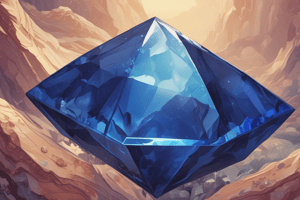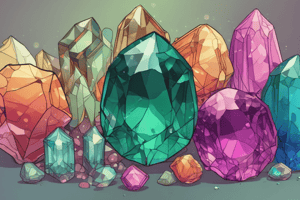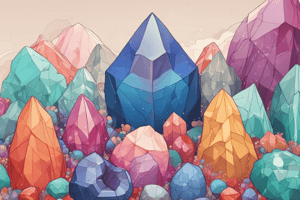Podcast
Questions and Answers
What is the meaning of 'Padparadscha'?
What is the meaning of 'Padparadscha'?
- A type of fancy sapphire
- A purple sapphire
- A type of orange sapphire
- Means 'lotus flower' in local language (correct)
Which of the following countries is NOT considered a traditional source of Padparadscha sapphires?
Which of the following countries is NOT considered a traditional source of Padparadscha sapphires?
- Tanzania
- Myanmar (correct)
- Vietnam
- Sri Lanka
What is the trade name for purple sapphires?
What is the trade name for purple sapphires?
- Rose sapphire
- Amethystine sapphire
- Plum sapphire
- All the Above (correct)
What is the term for sapphires that change color under different lighting conditions?
What is the term for sapphires that change color under different lighting conditions?
Which of the following countries is NOT a known source of Pink Sapphires?
Which of the following countries is NOT a known source of Pink Sapphires?
What is the term for sapphires with a star-shaped inclusion?
What is the term for sapphires with a star-shaped inclusion?
What is the term for black star sapphire with golden or yellow rays?
What is the term for black star sapphire with golden or yellow rays?
Which of the following methods is used to create red and orange corundum and star rubies?
Which of the following methods is used to create red and orange corundum and star rubies?
What is the most common imitation material for fancy sapphires?
What is the most common imitation material for fancy sapphires?
In which year were the first flame-fusion star rubies and star sapphires synthesized?
In which year were the first flame-fusion star rubies and star sapphires synthesized?
What is the industrial use of synthetic sapphire in display screens for smartphones?
What is the industrial use of synthetic sapphire in display screens for smartphones?
Which of the following is NOT a method of corundum synthesis?
Which of the following is NOT a method of corundum synthesis?
What is the preferred colorless diamond substitute?
What is the preferred colorless diamond substitute?
Where are sapphires found in a pastel color range?
Where are sapphires found in a pastel color range?
What is the name of the method used by Russian producers to make a wide range of fancy sapphires?
What is the name of the method used by Russian producers to make a wide range of fancy sapphires?
What is the name of the method used to create pink and orange fancy sapphires?
What is the name of the method used to create pink and orange fancy sapphires?
Which of the following is an industrial use of synthetic sapphire?
Which of the following is an industrial use of synthetic sapphire?
Which trace elements are found in Padparadscha sapphires?
Which trace elements are found in Padparadscha sapphires?
What basic hues are found in daylight-equivalent light for Color Change Sapphires?
What basic hues are found in daylight-equivalent light for Color Change Sapphires?
Which sapphire variant undergoes a color change from green in daylight to reddish brown in incandescent light?
Which sapphire variant undergoes a color change from green in daylight to reddish brown in incandescent light?
Which sapphire is described as having a vivid blue to violetish blue color?
Which sapphire is described as having a vivid blue to violetish blue color?
What element causes color change in Color Change Sapphires?
What element causes color change in Color Change Sapphires?
Which type of sapphire's asterism phenomenon is caused by Hematite inclusions?
Which type of sapphire's asterism phenomenon is caused by Hematite inclusions?
What is the crystal structure of sapphire?
What is the crystal structure of sapphire?
Which color range and tone combination best describes the finest padparadscha sapphires?
Which color range and tone combination best describes the finest padparadscha sapphires?
Which country highly values yellow sapphires due to association with royalty?
Which country highly values yellow sapphires due to association with royalty?
In terms of market size, what is the status of black sapphires despite the popularity of black diamonds?
In terms of market size, what is the status of black sapphires despite the popularity of black diamonds?
What saturation level is associated with the finest yellow sapphires?
What saturation level is associated with the finest yellow sapphires?
Padparadscha sapphires are a combination of which two hues?
Padparadscha sapphires are a combination of which two hues?
Which sapphire variety is described as having a whole range of tones with intensely saturated combinations?
Which sapphire variety is described as having a whole range of tones with intensely saturated combinations?
From which country are natural yellow sapphires often in demand apart from Southeast Asia?
From which country are natural yellow sapphires often in demand apart from Southeast Asia?
What is the characteristic of the finest orange sapphires?
What is the characteristic of the finest orange sapphires?
Which type of sapphire has a range of tones from reddish purple to violetish purple?
Which type of sapphire has a range of tones from reddish purple to violetish purple?
What is the characteristic of the finest yellow sapphires?
What is the characteristic of the finest yellow sapphires?
What is the characteristic of green sapphires?
What is the characteristic of green sapphires?
What is the MOHS SCALE of sapphire?
What is the MOHS SCALE of sapphire?
What is the species of sapphire?
What is the species of sapphire?
What is the characteristic of the most expensive star corundum?
What is the characteristic of the most expensive star corundum?
What is the cause of the asterism phenomenon in black star sapphires?
What is the cause of the asterism phenomenon in black star sapphires?
What is the typical shape of the crystal structure of sapphires?
What is the typical shape of the crystal structure of sapphires?
What is the characteristic of Trapiche sapphires?
What is the characteristic of Trapiche sapphires?
What is the characteristic of the body color of blue star sapphires?
What is the characteristic of the body color of blue star sapphires?
What is the characteristic of Color Change Sapphires in incandescent light?
What is the characteristic of Color Change Sapphires in incandescent light?
What is the primary method used to create synthetic sapphires in a variety of colors?
What is the primary method used to create synthetic sapphires in a variety of colors?
In which area of Montana are sapphires found in a pastel color range?
In which area of Montana are sapphires found in a pastel color range?
What is the primary industrial use of synthetic sapphires?
What is the primary industrial use of synthetic sapphires?
Which country uses the pulling process to create red, blue, and colorless corundum?
Which country uses the pulling process to create red, blue, and colorless corundum?
What is the name of the method used to create pink and orange fancy sapphires?
What is the name of the method used to create pink and orange fancy sapphires?
Which of the following is a common treatment for sapphires?
Which of the following is a common treatment for sapphires?
What type of sapphire is characterized by its availability in a range of colors, except red, which is classified as a star ruby?
What type of sapphire is characterized by its availability in a range of colors, except red, which is classified as a star ruby?
Which type of sapphire is known for its 'alexandrite-like' color-changing properties, but is much less expensive than actual alexandrite?
Which type of sapphire is known for its 'alexandrite-like' color-changing properties, but is much less expensive than actual alexandrite?
What is the characteristic of a 'golden star' sapphire?
What is the characteristic of a 'golden star' sapphire?
Which type of sapphire is characterized by its vibrant pink color and is highly prized in the market?
Which type of sapphire is characterized by its vibrant pink color and is highly prized in the market?
Which country is known for producing a variety of corundum colors, including star rubies and star sapphires?
Which country is known for producing a variety of corundum colors, including star rubies and star sapphires?
What type of sapphire is often found in pastel colors?
What type of sapphire is often found in pastel colors?
Which type of sapphire is characterized by its vibrant purple color and is often referred to as 'amethystine' or 'plum' sapphire?
Which type of sapphire is characterized by its vibrant purple color and is often referred to as 'amethystine' or 'plum' sapphire?
Which type of sapphire is characterized by its vibrant yellow or orange color and is often found in East Africa and Southeast Asia?
Which type of sapphire is characterized by its vibrant yellow or orange color and is often found in East Africa and Southeast Asia?
What is the common characteristic of 'fingerprint' inclusions in fancy sapphires?
What is the common characteristic of 'fingerprint' inclusions in fancy sapphires?
Flashcards are hidden until you start studying
Study Notes
Fancy Sapphires
- Montana's Missouri River and Dry Cottonwood and Rock Creek areas produce sapphires in a pastel color range.
Common Treatments and Synthetic Processes
- Common treatments: heat treatment, Beryllium lattice diffusion, artificial irradiation, and glass filling.
- Main synthetic process: flame fusion/Verneuil method.
- Other synthetic processes: pulling, flux, floating zone, and hydrothermal.
- Russia uses pulling to create red, blue, and colorless corundum.
- Russian producers use hydrothermal process to create a wide range of fancy sapphires, including color-change stones.
Industrial Uses for Synthetic Sapphire
- Used in lasers, highly energy-efficient circuitry, and LEDs.
- Used in scratch-resistant display screens, fingerprint scanners, and touchscreens for smartphones.
Common Imitation Materials
- Glass is the most common fancy sapphire imitation material.
- Doublets also mimic fancy sapphire and star corundum.
- Cubic zirconia (CZ) is another imitation material.
- White/Colorless sapphire is preferred over other diamond substitutes like synthetic cubic zirconia.
Countries of Origin
- Padparadscha: Sri Lanka, Africa, and Vietnam.
- Pink Sapphire: Sri Lanka, Myanmar, Madagascar, Mozambique, Vietnam, Montana, and other locations.
- Yellow and Orange: Sri Lanka, East Africa, Australia, Montana, and Southeast Asia.
- Green: Vietnam, Thailand, Montana, and Australia.
- Purple: Vietnam.
- Black Stars: Thailand and Australia.
- Color Changing: Australia.
- Blue Star: Thailand.
Chemical Composition
- Padparadscha: traces of iron and chromium.
- Pink Sapphire: trace elements chromium.
- Purple Sapphire: varying combinations of iron, titanium, and chromium.
- Yellow & Orange: trace elements iron and possibly chromium, or from color centers, basaltic material.
- Green: a mixture of two different color-causing mechanisms: yellow, caused by iron, and blue, caused by an iron and titanium intervalence charge transfer.
- Color Change: trace element is vanadium.
Crystal Structure and Possible Phenomena
- Barrel- or spindle-shaped hexagonal pyramid or bipyramid.
- Possible phenomena: asterism, color-change.
Clarity Characteristics
- Star Sapphire: tiny, needle-like inclusions rutile, usually made up of 2, 3, or 6 intersecting bands, resulting in 4, 6, or 12 rays.
- Trapiche sapphire: extremely rare, with strong bands of color that form along the crystal's hexagonal growth zones.
Studying That Suits You
Use AI to generate personalized quizzes and flashcards to suit your learning preferences.




